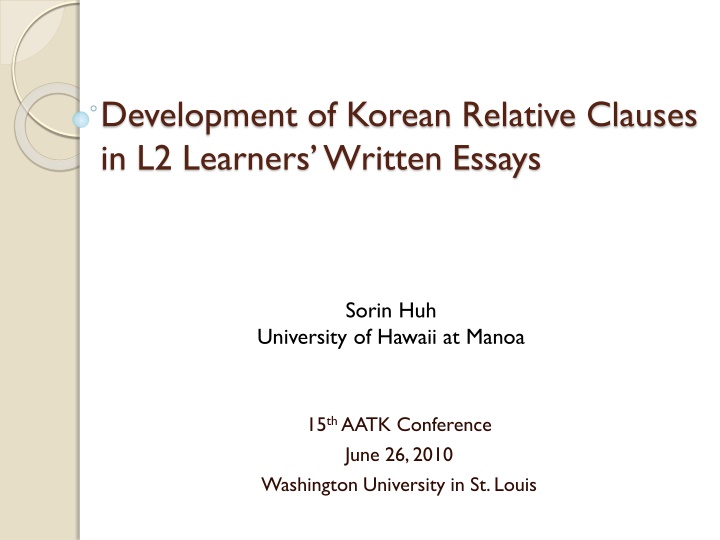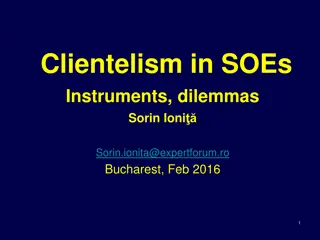
Korean Relative Clauses in L2 Learners' Essays
Explore the development of Korean relative clauses in second language learners through written essays, investigating the influence of typological differences and the order of RC development. Characteristics of Korean RCs and NP Accessibility Hierarchy are discussed, along with L1 and L2 acquisition studies supporting the developmental order of RCs.
Download Presentation

Please find below an Image/Link to download the presentation.
The content on the website is provided AS IS for your information and personal use only. It may not be sold, licensed, or shared on other websites without obtaining consent from the author. If you encounter any issues during the download, it is possible that the publisher has removed the file from their server.
You are allowed to download the files provided on this website for personal or commercial use, subject to the condition that they are used lawfully. All files are the property of their respective owners.
The content on the website is provided AS IS for your information and personal use only. It may not be sold, licensed, or shared on other websites without obtaining consent from the author.
E N D
Presentation Transcript
Development of Korean Relative Clauses in L2 Learners Written Essays Sorin Huh University of Hawaii at Manoa 15thAATK Conference June 26, 2010 Washington University in St. Louis
Purposes of the Study To examine the development of Korean relative clauses (RCs) by second language (L2) learners of Korean at the descriptive level by analyzing L2 learners written essays using CHILDES. 1. To investigate whether typological differences between the target language and learners first language (L1) have influence on their acquisition of the Korean RCs 2.
Characteristics of Korean RCs 1. Korean RC is prenominal. 2. No relative pronoun is involved. 3. Instead, relativization is signaled by a set of adnominal verbal suffixes such as , , and , which also express the tense of the RC. 4. Movement and pronominalization are not involved.
Characteristics of Korean RCs Head-external RCs Gap Head Noun [NP [ti - - ] i ] baby-ACC see-REL.PRES woman The woman who looks at a baby. Head-internal RCs Head Noun - [NP[ - ] ]- . John-TOP book-ACCborrow-REL.PAST thing-COMP.ACCreturn-AUX-PAST-DEC. John returned the book he borrowed. (from Jeon & Kim, 2007, p. 256)
Development of Korean RCs L1 (Cho, 1999; Cho & O Grady, 2009; Y. Kim, 1987; K. Lee, 1991) and L2 acquisition studies (Jeon & Kim, 2007) have shown that Korean RCs develop in the order of: Head- Internal RCs Head- External RCs Headless RCs No Head Noun that man [lift-REL.PRES COMP] What the man has lifted
Noun Phrase Accessibility Hierarchy A typological generalization originally proposed by Keenan and Comrie (1977) The relativizability of noun phrase is in the order of: SU > DO > IO > OBL > GEN > OComp
NPAH and L2 Acquisition The NPAH was extended to SLA to predict the difficulty order of acquiring RCs. Research on European RC acquisition confirmed the NPAH. In other words, subject (SU) RCs are acquired earlier than direct object (DO) RCs. (Eckman, Bell, & Nelson, 1988; Gass, 1979; Doughty, 1999; Izumi, 2003, Hawkins, 1989, Hyltenstam, 1984) The NPAH has been regarded as a universal hierarchy which predicts L2 developmental order of RCs.
NPAH and L2 Acquisition Recent findings on the acquisition of East Asian Language (EAL) RCs have challenged the universality of the NPAH. Japanese RC acquisition: Mixed findings (Kanno, 2000, 2001, 2007; Sakamoto & Kubota, 2000 vs. Hasegawa, 2002; Roberts , 2000; Ozeki & Shirai , 2007) Korean RC acquisition: Favorable findings (Huh, in press; Jeon & Kim, 2007; O Grady et al, 2000, 2003)
Influence of L1 on L2 RC acquisition Kanno (2007) Word order: SVO vs. SOV Filler-Gap order: Prenominal (gap-filler) vs. Postnominal (filler-gap) Word Order SVO SOV Gap-Filler Prenominal Prenominal Chinese (CHN) Japanese (JPN) Interestingly, CHN learners did not perform better than other learners with SVO postnominal L1. In other words, having prenominal RCs was not advantageous for the CHN learners. In this study, only learners with CHN and JPN L1 backgrounds will be included.
Research Questions Do L2 learners of Korean show RC developmental order from headless to head-internal to head- external RCs? 1. Do L2 learners of Korean acquire the Korean RCs in the order consistent with the NPAH? 2. Does word order difference in L1 and L2 influence learners acquisition of the Korean RCs? 3.
Methods: Korean Learner Corpus L2 Korean Learner Corpus In total, 406 essays written by 203 Korean as a second language (KSL) learners from beginning to high-advanced level were included in the analysis. Among them, 153 were JPN learners and 50 were CHN learners. Essays were written on various topics. (e.g., Introducing my family, describing a picture, writing opinions about controversial issues, future plans, etc.)
Methods: Korean Learner Corpus CHILDES (McWhinney, 2000) A database of child language transcripts A system of Codes for the Human Analysis of Transcripts of child speech (CHAT) A collection of Child Language Analysis programs (CLAN) The essays were converted into the CHAT format and analyzed using CLAN. http://childes.psy.cmu.edu/
Methods: Coding and Analysis All sentences containing noun-modifying clauses were extracted. Distinction of an RC (Ozeki & Shirai, 2007a, b) Verbs RCs Adjectives with Complements Adjectives in Past Tense Form
Methods: Coding and Analysis Distinction between RCs and other similar clauses (Lee, 2001; Sohn, 1999) RCs RCs Pseudo Relative Clauses (Coreferent-Opaque Clauses) No RCs Noun Complement Clause (Fact-S Type Clauses) Further tests for RCs distinction (Lee, 2001) 3. Can a Psuedo-cleft sentence be made from the RC? 1. Is there a Gap inside the RC? 2. Can the gap be filled with a RP?
Methods: Coding and Analysis RC Developmental Stages 7 RC developmental stages from headless to head-internal and head-external RCs (according to Jeon and Kim, 2007) RC Gap Type Subject (SU)/Direct object (DO)/Oblique (OBL) Types of Errors Tense/inflection error (TIE) Case marker error (CME) Argument omission (ARG) Resumptive pronoun retention (RPR)
Results: Types of RCs Produced Table 1. No. of RCs produced L1 L2 L3 L4 L5 L6 Total Total 62 91 263 158 119 119 812 RC/Learner 1.17 2.33 6.41 5.45 4.58 7.93 4.00 (Min-Max) (0-4) (0-7) (1-13) (0-11) (1-13) (3-15) (0-15) In total, 812 RCs were produced. All of the RCs identified in this study were head-external RCs. Number of RCs per learner seems to increase as learner s level becomes higher. Dramatic increment appeared at Level 3 both in the number of RCs per learner and the maximum number of RCs produced.
Results: Types of RCs Produced Table 2. Accuracy of the RCs produced L1 L2 L3 L4 L5 L6 Total RC 62 91 263 158 119 119 812 Accurate RCs 47 76 225 142 113 108 711 Accuracy (76%) (84%) (86%) (90%) (95%) (91%) (88%) In general, learners produced RCs more accurately as their level increased. Error types: Tense/inflection error (69%), case marker error (17%), and argument omission (14%)
Results: RC Gap Types Table 3. Gap positions of the RCs L1 L2 L3 L4 L5 L6 Total SU 81% 62% 72% 57% 71% 51% 65% DO 16% 14% 14% 30% 19% 24% 19% OBL 3% 24% 14% 13% 10% 25% 15% At all levels, SU RCs were produced much more frequently than other types of RCs (SU > DO/OBL). In total, larger proportion of DO RCs were produced than OBL, however such a pattern was not clearly shown at each level.
Results: RC Gap Types Table 4. Accuracy of each gap type L1 L2 L3 L4 L5 L6 SU 80% 84% 87% 90% 95% 90% DO 50% 69% 92% 89% 96% 93% OBL 100% 91% 73% 90% 92% 90% After finishing level 3, learners seem to be able to produce all three types of RCs quite confidently. It should be noted than there were only 2 OBL RCs produced in Level 1.
Results: The Effects of L1 Table 5. No. of RCs and accuracy in each L1 group L1 L2 L3 L4 L5 L6 Total JPN RC/ L 1.28 2.61 7.11 5.76 4.75 9.40 4.22 Accuracy 78% 83% 88% 93% 99% 93% 90% CHN RC/ L 0.70 1.25 4.92 4.63 4.00 5.00 3.34 Accuracy 57% 90% 77% 78% 79% 84% 78% At all levels, JPN learners produced greater number of RCs than CHN learners (JPN > CHN). In addition, JPN learners produced RCs more accurately than CHN learners.
Results: The Effects of L1 Table 6. RC gap positions for each L1 group L1 82% 15% 4% L2 63% 14% 23% L3 75% 12% 13% L4 56% 29% 15% L5 71% 22% 7% L6 51% 24% 24% JPN SU DO OBL CHN SU DO OBL 71% 29% 0% 50% 20% 30% 63% 19% 19% 59% 32% 8% 71% 8% 21% 52% 20% 28% Both groups of learners produced SU RCs in much greater proportion than DO and OBL RCs.
Results: Learners L1 Effects Table 7. Error types by each L1 group TIE 48 (75%) 21 (58%) AGO 9 (14%) 5 (14%) CME 7 (11%) 10 (28%) RPR 0 (0%) 1 (3%) Total 64 (100%) 36 (100%) JPN CHN JPN learners made much greater number of tense/inflection errors (TIE) than the other types of errors. TIE was indeed the largest number of errors committed by CHN learners. However, considerable proportion of case marker errors (CME) were also produced.
Discussion: Development of RCs (RQ1) Head-external RCs from the beginning level (L1) No indication of headless or head- internal RC stages unlike previous studies Level 6 7.93 RC/L Level 3 6.41 RC/L Considerably larger number of RCs as learners level increased U-shape pattern of RC development Level 4 5.45 RC/L Level 5 4.58 RC/L
Discussion: RC Gap Positions (RQ2) SU RCs were produced more frequently than DO and OBL RCs at all levels, supporting the NPAH. After completing level 3, the learners seem to be able to produce all three types of RCs quite successfully (over 90% accuracy). However, no clear developmental pattern was manifested for DO and OBL RCs.
Discussion: L1 effects (RQ3) Overall JPN learners produced the Korean RCs more frequently and accurately than CHN learners. JPN: 4.22 RCs/L, 90% accuracy CHN: 3.34 RCs/L, 78% accuracy Types of errors made by each group seem to reflect the characteristics of their L1. Japanese: TIE > AGO > CME Chinese: TIE > CME > AGO Lack of adnominal verbal suffixes Lack of case markers (CHN)
Limitations & Conclusions Limitations & Suggestions The small size of the learner corpus Lack of control over the corpus Unequivalent number of learners in each L1 group Different topics across levels and varied length of the essays Conclusions 1. The KSL learners produced Korean head-external RCs from the beginning unlike children or other KFL learners in the previous studies. 2. The acquisition order of the NPAH was supported in this study; SU RCs were developed earlier than DO/OBL RCs. 3. The effects of learners L1 were manifested in this study; JPN learners produced the Korean RCs more frequently and accurately than CHN learners.
References Cho, S. (1999). The acquisition of relative clauses: Experimental studies on Korean. Unpublished doctoral dissertation, University of Hawaii at Manoa. Cho, S., & O Grady, W. (2009). The accessibility hierarchy in Korean: head-external and head-internal relative clauses, 168-174 Doughty, C. (199). Second language instruction does make a difference: Evidence from an empirical study of SL relativization. Studies in Second Language Acquisition, 13(4), 431 469. Eckman, R., Bell, L., & Nelson, D. (1988). On the generalization of relative clause instruction in the acquisition of English as a second language. Applied Linguistics, 9(1) 1 20. Gass, S. M. (1979). Language transfer and universal grammatical relations. Language Learning,29(2), 327 344. Hasegawa, T. (2002). The acquisition of relative clauses by children learning Japanese as a second language. Unpublished manuscript, University of Hawai i at M noa, Honolulu. Hawkins, R. (1989). Do second language learners acquire restrictive relative clauses on the basis of relational or configurational information? The acquisition of French subject, direct object and genitive restrictive relative clauses by second language learners. Second Language Research, 5(2), 158 188. Hyltenstam, K. (1984). The use of typological markedness conditions as predictors in second language acquisition: The case of pronominal copies in relative clauses. In R. Andersen (Ed.), Second languages: A cross-linguistic perspective (pp. 39 60). Rowley. MA: Newbury House. Huh, S. (in press). Does Noun Phrase Accessibility matter? A study of L2 Korean relative clause production. In S. Cheon, (Eds.). Japanese/Korean Linguistics, 19, Stanford, CA: CSLI Publications. Izumi, S. (2003). Processing difficulty in comprehension and production of relative clauses by learners of English as a second language. Language Learning, 53(2), 285 323. Jeon, K. S. & Kim, H-Y. (2007). Development of relativization in Korean as a foreign language. Studies in Second Language Acquisition, 29, 253-276. Kanno, K. (2000). Sentence processing by JSL learners. Paper presented at the Second Language Research Forum 2000, Madison, WI. Kanno, K. (2001). On-line processing of Japanese by English L2 learners. Acquisition of Japanese as a Second Language, 4, 23 28. Kanno, K. (2007). Factors affecting the processing of Japanese relative clauses by L2 learners. Studies in Second Language Acquisition, 29(2), 197 218. Kim, Y. (1987). The acquisition of relative clauses in English and Korean: Development in spontaneous production. Unpublished doctoral dissertation, Harvard University, Cambridge, MA. Lee, K. (1991). On the first language acquisition of relative clauses in Korean: The universal structure of COMP. Unpublished doctoral dissertation, Cornell Unive rsity, Ithaca, NY. Lee, S. (2001). Pseudo-Relative Clauses in Korean, ICKL Proceedings, 305-321. MacWhinney, B. (2000). The CHILDES Project: Tools for Analyzing Talk. 3rd Edition. Mahwah, NJ: Lawrence Erlbaum Associates O Grady, W., Lee, M., & Choo, M. (2003). A subject-object asymmetry in the acquisition of relative clauses in Korean as a second language. Studies in Second Language Acquisition, 25, 433-448. O Grady, W., Yamashita, Y., Lee, M., Choo, M., & Cho, S. (2000). Computational factors in the acquisition of relative clauses. Proceedings of the International Conference on the Development of the Mind, (pp. 433-448). Tokyo: Keio University Ozeki, H., & Shirai, Y. (2007a). Does the noun phrase accessibility hierarchy predict the difficulty order in the acquisition of Japanese relative clauses? Studies in Second Language Acquisition, 29(2), 169 196. Ozeki, H., & Shirai, Y. (2007b). The consequences of variation in the acquisition of relative clauses: An analysis of longitudinal production data from five Japanese children. In Y. Matsumoto, D. Y. Oshima, O.W. Robinson, & P. Sells (Eds.), Diversity in language: Perspectives and implications, 243-70. Stanford, CA: CSLI Publications. Roberts, M. A. (2000). Implicational markedness and the acquisition of relativization by adult learners of Japanese as a foreign language. Unpublished doctoral dissertation, University of Hawai i at M noa. Honolulu. Sohn, H. M. (1999). The Korean language. Cambridge: Cambridge University Press.
Methods: Korean Learner Corpus Essay Topics Essay 1 Essay 2 Topics after studying Korean at the institution L1 Introduing my family L2 Describing a given picture Public transportation in my home country Writing opinions about a fixed idea (a pretty girl is not smart) L3 Writing a complaining letter Writing opinions about the 10th-day-no- driving system L4 My favoraite animal Difference between my first language and Korean L5 Writing opinions about eating dog soup Things to improve about living in Korea or Korean people L6 Writing opinions about runaway teenagers
Methods: Korean Learner Corpus No. of Participants L1 L2 L3 L4 L5 L6 Total JPN 43 31 28 21 20 10 153 CHN 10 8 13 8 6 5 50 Total 53 39 41 29 26 15 203
Methods: Korean Learner Corpus No. of Participants, Writings, and Tokens L1 L2 L3 L4 L5 L6 Total JPN 43 31 28 21 20 10 153 CHN 10 8 13 8 6 5 50 Total 53 39 41 29 26 15 203
Methods: Korean Learner Corpus Table 1. No. of Learners, Essays, and L1 L2 L3 L4 L5 L6 Total 53 39 41 29 26 15 203 Learners Essays 106 78 82 58 52 30 406
Korean Relative Clauses [NP [ti aki-lul po-nun] yecai ] baby-ACC see-REL.PRES woman The woman who is looking at a baby. SU [NP [yeca-ka tj po-nun] akij ] woman-NOM see-REL.PRES baby The baby whom the woman is looking at DO [NP [namca-ka tk phyenci-lul ssu-nun] yecak] man-NOM letter-ACC write-REL.PRES woman The woman to whom the man is writing a letter IO [NP [namca-ka tk phyenci-lul ssu-nun] phenk] man-NOM letter-ACC write-REL.PRES pen The pen with which the man is writing a letter OBL
Development of Korean RCs A small number of studies have been conducted. L1 Acquisition (Cho, 1999; Y. Kim, 1987; K. Lee, 1991) L2 Acquisition (Huh, 2009; Jeon & Kim, 2007; O Grady, et al., 2000, 2003) Similar findings were obtained from L1 and L2 studies. SU RCs are more easily acquired than DO. NPAH No studies have investigated L2 acquisition of OBL RCs.
Methods: Korean Learner Corpus Table 1. Number of learners and essays L1 L2 L3 L4 L5 L6 Total Learners JPN 43 31 28 21 20 10 153 CHN 10 8 13 8 6 5 50 53 39 41 29 26 15 203 Total Essays 106 78 82 58 52 30 406
Results 1: Types of RCs Produced Table 2. Accuracy of the RCs produced L1 L2 L3 L4 L5 L6 Total RC 62 91 263 158 119 119 812 Accurate RCs 47 76 225 142 113 108 711 Accuracy 76% 84% 86% 90% 95% 91% 88% In general, learners produced RCs more accurately as their level increased. Error types: TIE (69%), CME (17%), & AGO (14%)
Results 3: Learners L1 Effects Table 6. RC accuracy by each L1 group L1 L2 L3 L4 L5 L6 Total JPN 78% 83% 88% 93% 99% 93% 90% CHN 57% 90% 77% 78% 79% 84% 78% In general, JPN learners produced RCs more accurately than CHN learners. Even at the high-advanced level, CHN learners did not reach the accuracy level of the JPN learners.
Discussion: Development of RCs (RQ1) The KSL learners included in this study were able to produce head-external Korean RCs quite successfully from the beginning level (L1). No occurrence of headless or head-internal RCs were identified. The learners produced noticeably greater number of RCs as their level increased (1.17 -> 7.93).





